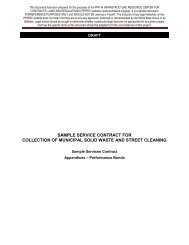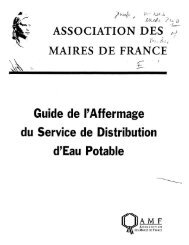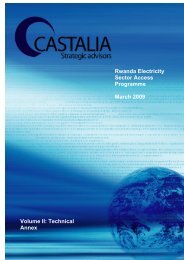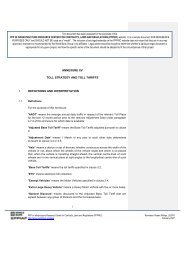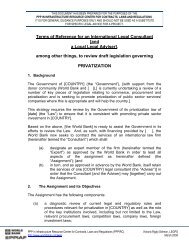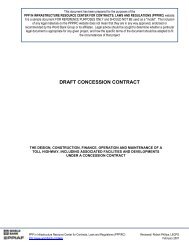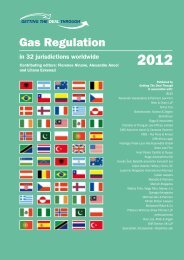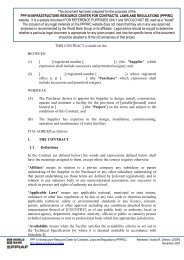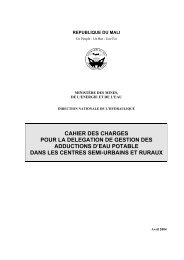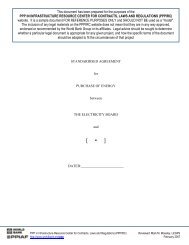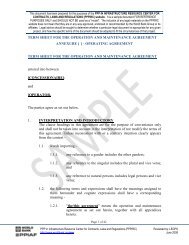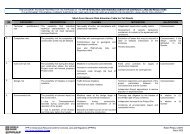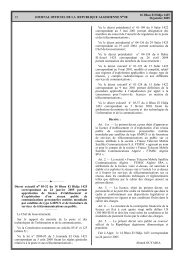Volume I: Investment Prospectus Rwanda Electricity Sector Access ...
Volume I: Investment Prospectus Rwanda Electricity Sector Access ...
Volume I: Investment Prospectus Rwanda Electricity Sector Access ...
- No tags were found...
Create successful ePaper yourself
Turn your PDF publications into a flip-book with our unique Google optimized e-Paper software.
which estimate 370GWh of domestic electricity demand in 2010 and 965GWh in2015 24• Generation is shown by the vertical coloured bars in the chart, ordered fromplants with the lowest operating cost (existing hydro stations) to highest operatingcost (thermal plants). Lowest-cost available generation is used first to meetdemand, assuming different availability and utilisation of different plants. 25 Theanalysis in this <strong>Prospectus</strong> assumes that available generation is dispatched first tomeet existing demand, and is then dispatched to meet demand from newconnections made under the access programme. This approach uses the marginalcost of generation to determine the cost of the access programme, rather thanusing average generation costs which are considerably lower• New generation plants are scheduled to come on-line according to currentexpected commissioning dates. The “new hydro” generation shown in Figure 5.3refers to the 9.5MW plant at Rukarara (available from the end of 2009) and the27.5MW plant being built at Nyaborongo (expected to be commissioned in 2013).The new 25MW methane gas plant is assumed to be available in the first quarterof 2011, and new micro-hydro plants are expected to be commissionedincrementally from 2009–2012• The marginal generation plant is assumed to be the recently commissionedheavy fuel oil (HFO) plant developed under the UERP. Oil prices are assumed toincrease to US$100 per barrel by the end of 2009, and remain at that price (in real2009 dollars). 26 This plant, together with the existing Jabana diesel plant, will beoperated where necessary to meet demand. The analysis in this <strong>Prospectus</strong>suggests that the HFO plant will initially need to be operated as a baseloadgenerator, but will shift to a peaking and exporting role as new, lower-costgeneration sources are commissioned. This <strong>Prospectus</strong> assumes that when newsources of generation are available the HFO plant generates electricity duringpeak periods. 27 Where sufficient surplus capacity is available from the HFO plant,energy is assumed to be exported at a price 25 percent higher than the cost ofgeneration.The total estimated costs of operating the electricity system in <strong>Rwanda</strong> are presented inTable 5.4 (below), including operations and maintenance expenses, staffing andadministrative costs. An operating contingency has also been factored in to account for theefficiencies that are expected to be achieved over the next four years. This contingency startsat 10 percent of other operating costs and falls to five percent by 2012.24 See Fichtner. “Rapport Final de la Phase I. <strong>Volume</strong> 1: Rassemblement des donnees economiques et prevision de lademande” 2009, Tableau 7-21.25 Availability assumptions are particularly important for hydro generation plants, which rely on water availability togenerate electricity. In recent years, hydro plants in <strong>Rwanda</strong> have been constrained due to lower than average rainfall.The assumptions used in this <strong>Prospectus</strong> are from Vernstrom (2008).26 Sensitivity analysis suggests that changes in the oil price will not have a major impact on sector operating costs, unless oilprice changes are combined with a significant delay in the commissioning of the planned 25MW methane gas generationplant at Lake Kivu. This is because the commissioning of methane gas generation will reduce the need for generationfrom the HFO plant.27 The peak period in <strong>Rwanda</strong> is assumed to last for four hours during weekday evenings.49



